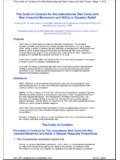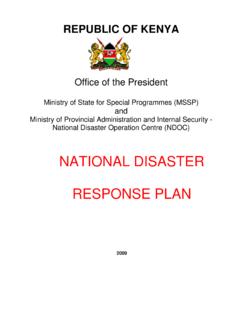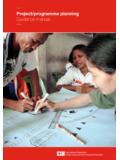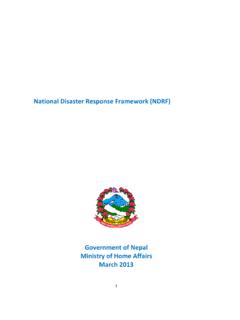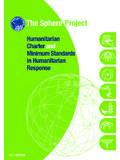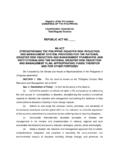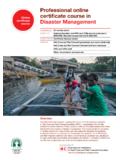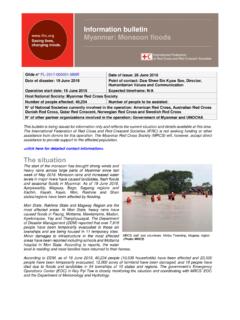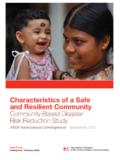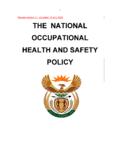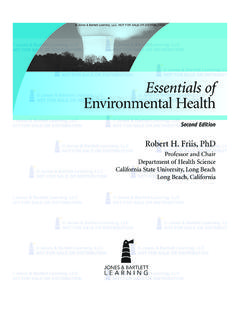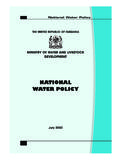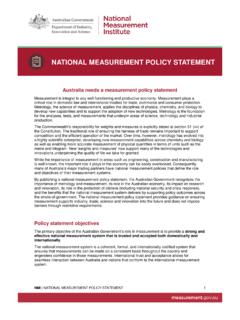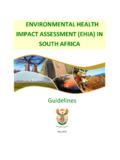Transcription of NATIONAL POLICY FOR DISASTER MANAGEMENT …
1 GOVERNMENT OF KENYA. MINISTRY OF STATE FOR SPECIAL PROGRAMMES. OFFICE OF THE PRESIDENT. NATIONAL POLICY . FOR. DISASTER MANAGEMENT IN KENYA. MARCH, 2009. LIST OF ABBREVIATIONS. ASAL Arid and Semi Arid Lands AU Africa Union CBD Convention on Biological Diversity CBOs Community Based Organizations CEWARN Conflict Early Warning and Response Network CSOs Civil Society Organisations DM DISASTER MANAGEMENT DRR DISASTER Risk Reduction ECOWAS Economic Community of West African States EWS Early Warning System GHA Greater Horn of Africa GRTS Geo Livelihood Review Teams HIV/AIDS Human Immune Virus/ Acquired Immuno-Deficiency Syndrome IGAD Intergovernmental Authority for Development IPCC Inter-governmental Panel on Climate Change ISDR International Strategy for DISASTER Response KFSM Kenya Food Security Meeting KFSSG Kenya Food Security
2 Steering Group M&E Monitoring and Evaluation MARPOL International Convention for Prevention of Pollution from Ships MDGs Millennium Development Goals MT Metric Tonnes MTEF Medium Term Expenditure Framework NADIMA NATIONAL DISASTER MANAGEMENT Agency NGOs Non-Governmental Organizations NOAA NATIONAL Oceanic and Atmospheric Administration PIC Prior Informed Consent POPs Persistent Organic Pollutants PRSP Poverty Reduction Strategy Paper RAMSAR Convention on Wetlands of International Importance SADC Southern African Development Community SOP Standard Operating Procedure UN United Nations UNCBD United Nations Convention on Biological Diversity UNCCD United Nations Convention to Combat Desertification UNFCCC United Nations Framework Convention on Climate Change 2.
3 Definitions of DISASTER MANAGEMENT Terms A Hazard: A hazard is a dangerous phenomenon, substance, human activity or condition that may cause the loss of life, injury or other health impacts, property damage, loss of livelihoods and services, social and economic disruption, or environmental damage. A Natural Hazard: Natural processes or phenomenon that may cause loss of life, injury or other health impacts, property damage, loss of livelihoods and services, social and economic disruption, or environmental damage. A Geological Hazard: Geological process or phenomenon that may cause lo loss of life, injury or other health impacts, property damage, loss of livelihoods and services, social and economic disruption, or environmental damage.
4 A Technological Hazard: A hazard originating from technological or industrial conditions, including accidents, dangerous procedures, infrastructure failures or specific human activities, that may cause loss of life, injury, illness or other health impacts, property damage, loss of livelihoods and services, social and economic disruption, or environmental damage. A DISASTER : A DISASTER is a serious disruption of the functioning of a community or society causing widespread human, material, economic or environmental loses which exceed the ability of the affected community/society to cope using its own resources. A DISASTER Risk: The potential DISASTER losses, in lives, health status, livelihoods, assets and services, which could occur to a particular community or a society over some specified future time period.
5 DISASTER Risk MANAGEMENT : The systematic process of using administrative directives, organisations, and operational skills and capacities to implement strategies, policies and improved coping capacities in order to lessen the adverse impacts of hazards and the possibility of DISASTER . DISASTER Risk Reduction: he concept and practice of reducing DISASTER risks through systematic efforts to analyze and manage the causal factors of disasters, including through reduced exposure to hazards, lessened vulnerability of people and property, wise MANAGEMENT of land and the environment, and improved preparedness for adverse events. Risk Assessment: A methodology to determine the nature and extent of risk by analyzing potential hazards and evaluating existing conditions of vulnerability that together could potentially harm exposed people, property, services, livelihoods and the environment on which they depend.
6 3. Climate Change: A change in the state of the climate that can be identified ( by using statistical tests) by changes in the mean and/or the variabilities of its properties and that persist for an extended period, typically decades or longer. Climate Change may be due to natural internal processes or external forcings or to persistent anthropogenic changes in the composition of the atmosphere or land use. Adaptation to Climate Change: The adjustment in natural or human activities in responses to actual or expected climate stimuli or their effects which moderate harm or exploit beneficial opportunities. Vulnerability: The characteristics and circumstances of a community, system or asset that makes it susceptible to the damaging effects of a hazard.
7 4. FOREWORD. Kenya's DISASTER profile is dominated by droughts, fire, floods, terrorism, technological accidents, diseases and epidemics that disrupt people's livelihoods, destroy the infrastructure, divert planned use of resources, interrupt economic activities and retard development. In the pursuit of reducing vulnerabilities to risks, the Government has formulated this NATIONAL POLICY on DISASTER MANAGEMENT to institutionalise mechanisms for addressing disasters. Recent DISASTER events, the successive Reports of the Inter-governmental Panel Climate Change (IPCC), the recent Climate Change Conference (Nairobi , Nov. 2006), and a recent comprehensive environmental reconnaissance survey over the whole country have all stressed the central role of Climate Change in any sustainable planned and integrated NATIONAL Strategy for DISASTER MANAGEMENT .
8 The POLICY emphasizes preparedness on the part of the Government, communities and other stakeholders in DISASTER Risk Reduction activities. In this regard, the POLICY aims at the establishment and strengthening of DISASTER MANAGEMENT institutions, partnerships, networking and main streaming DISASTER Risk Reduction in the development process so as to strengthen the resilience of vulnerable groups to cope with potential disasters. Ministry of State for Special Programmes in the Office of President will coordinate DISASTER Risk Reduction initiatives within a unified POLICY framework in a proactive manner at all levels. DISASTER Risk MANAGEMENT encompasses a full continuum from preparedness, relief and rehabilitation, mitigation and prevention.
9 The POLICY aims to increase and sustain resilience of vulnerable communities to hazards through diversification of their livelihoods and coping mechanisms. This entails a shift from the short term relief responses to development. The POLICY will go a long way in preserving life and minimising suffering by providing sufficient and timely early warning information on potential hazards that may result to disasters. It will also aim at alleviating suffering by providing timely and appropriate response mechanisms for DISASTER victims. The preparation of this POLICY Paper has benefited from invaluable contribution from experts in various Ministries and organizations and it is hoped that the full implementation of this POLICY will contribute immensely to DISASTER risk reduction, effective DISASTER preparedness, response, recovery and reconstruction as well as contribute to poverty reduction and sustainable development in the country, particularly among those communities that have been identified as highly vulnerable to DISASTER risk, loss of life and livelihoods.
10 HON DR. NAOMI SHAABAN, EGH, MP. MINISTER OF STATE FOR SPECIAL PROGRAMMES. 5. ACKNOWLEDGEMENTS. The conceptual need to formulate a comprehensive DISASTER MANAGEMENT POLICY came to the fore about ten years ago; and many successive efforts followed with foundation documents, which were thereafter utilised in the research to formulate a concrete DISASTER MANAGEMENT POLICY document. Subsequently, particularly over the last nearly three years, starting October 2006, the process research for formulation of the DISASTER MANAGEMENT POLICY for Kenya has been a collaborative, contributory process involving many parties, the Government, Development Partners and stakeholders at all levels, NATIONAL , District and lower levels.
